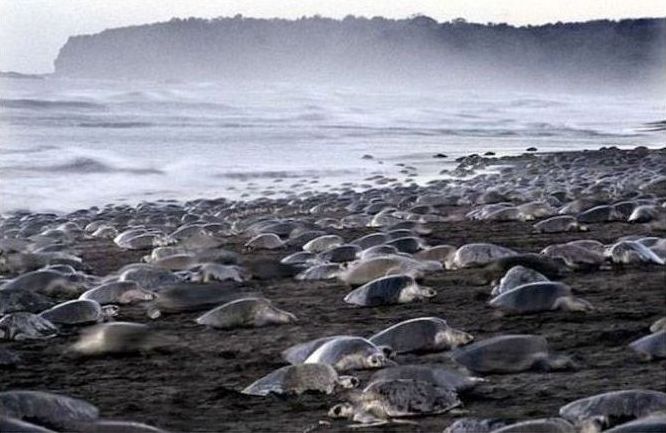|
|
Arribadas, Pacific Olive Ridley Sea Turtles Synchronised Nesting
|
Olive ridleys generally begin to aggregate near nesting beaches about two months before nesting season, although this may vary throughout its range. In the eastern Pacific, nesting occurs throughout the year, with peak nesting events (arribadas) occurring between September and December. Nesting beaches can be characterized as relatively flat, midbeach zone, and free of debris. Beach fidelity is common, but not absolute. Nesting events are usually nocturnal, but diurnal nesting has been reported, especially during large arribadas. Exact age of sexual maturity is unknown, but this can be somewhat inferred from data on minimum breeding size. For example, the average carapace length of nesting females (n = 251) at Playa Nancite, Costa Rica was determined to be 63.3 cm, with the smallest recorded at 54.0 cm. Females can lay up to three clutches per season, but most will only lay one or two clutches. The female will remain near shore for the internesting period, which is about one month. Mean clutch size varies throughout its range and decreases with each nesting attempt.
A mean clutch size of 116 (30–168 eggs) was observed in Surinam, while nesting females from the eastern Pacific were found to have an average of 105 (74–126 eggs). The incubation period is usually between 45 and 51 days under natural conditions, but may extend to 70 days in poor weather conditions. Eggs incubated at temperatures of 31 to 32°C will produce only females; eggs incubated at 28°C or less will produce solely males; and incubation temperatures of 29 to 30°C will produce a mixed sex clutch. Hatching success can vary by beach and year, due to changing environmental conditions and rates of nest predation.
• Habitat
Most observations are typically within 15 km of mainland shores in protected, relatively shallow marine waters (22–55 m deep). Olive ridleys are occasionally found in open waters. The multiple habitats and geographical localities used by this species vary throughout its life cycle. More research is needed to acquire data on and use of pelagic habitats.
|
|









